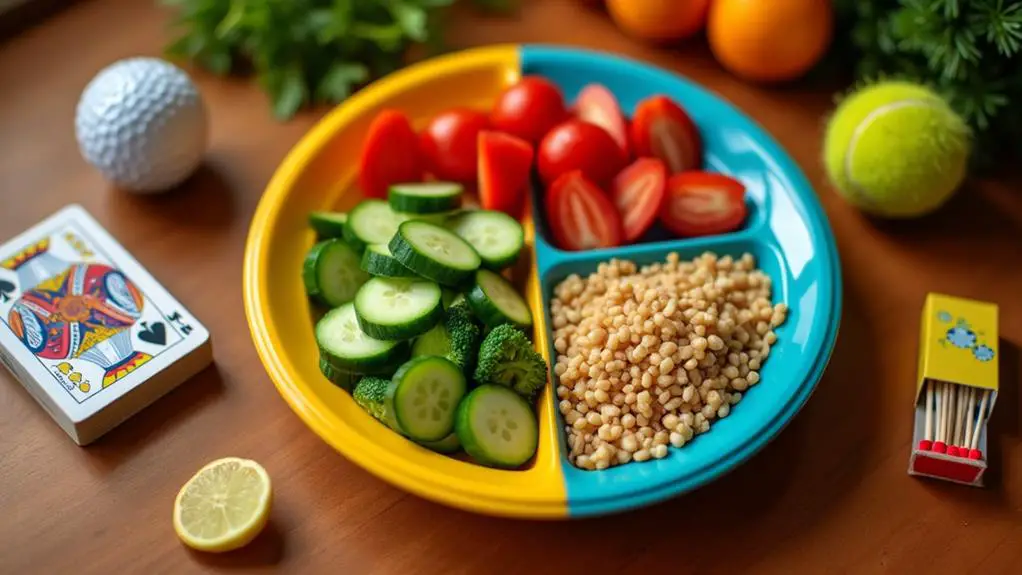Understanding the Basics of Portion Control for Families
Portion control is a vital strategy for managing your family's food intake and promoting healthy eating habits. It involves regulating meal and snack sizes to maintain a balanced diet and prevent overeating. By using visual guides, like comparing serving sizes to everyday objects, you can easily estimate appropriate portions without measuring tools. Implement family-friendly tactics, such as serving meals from the counter and using smaller plates, to encourage mindful eating. Teach your kids about proper portioning through hands-on activities and modeling good habits. Mastering portion control can lead to numerous benefits, including weight management, reduced food waste, and better overall health for your entire family. Discover how simple changes can transform your family's relationship with food.
Key Takeaways
- Use everyday objects as visual guides to teach portion sizes for different food groups.
- Serve meals from the counter to discourage overeating and promote mindful consumption.
- Utilize smaller plates and bowls to create the illusion of larger portions and control serving sizes.
- Involve children in meal preparation to educate them about appropriate serving sizes and healthy eating habits.
- Model mindful eating behaviors and encourage recognition of hunger and fullness cues during family meals.
What Is Portion Control?
Portion control is a food management strategy that helps you regulate the amount of food you eat at each meal or snack. It's essential for maintaining a healthy weight and preventing overeating.
By understanding portion sizes, you can better manage your caloric intake and make healthier food choices. Recommended serving sizes vary by food group. For instance, a serving of vegetables is about the size of a baseball, while a protein serving shouldn't be larger than a deck of cards.
To practice portion control effectively, you can use measuring tools like cups and scales to accurately gauge serving sizes.
Being aware of portion sizes isn't just about weight management; it can also reduce your risk of chronic diseases associated with overeating.
Benefits of Proper Portioning
Several key benefits arise from implementing proper portioning in your family's meals. By controlling portion sizes, you'll manage your family's caloric intake, reducing the risk of obesity and related health issues like type 2 diabetes and heart disease.
You'll also save money on groceries by minimizing food waste. Using visual cues, such as comparing protein servings to a deck of cards, helps you accurately control portion sizes.
This practice encourages children to develop healthy eating habits early on, fostering an understanding of moderation and nutrition. Proper portioning promotes a balanced diet by including various food groups while managing overall energy intake.
As a result, you'll reduce the likelihood of excessive weight gain and enjoy more nutritious meals. Ultimately, portion control leads to healthier, more mindful eating habits for your entire family.
Visual Guides for Serving Sizes

Visual guides offer a practical approach to implementing portion control in your family's meals. By using everyday objects as visual cues, you can easily estimate serving sizes for commonly eaten foods. For example, a medium pepper, comparable to a baseball, counts as one vegetable serving. A small apple, about the size of a tennis ball, represents one fruit serving.
When it comes to carbohydrates and proteins, think of a deck of cards:
- Half a cup of cooked pasta or rice
- 3 ounces of meat like chicken or beef
- 2 teaspoons of fats such as mayonnaise or butter (size of a pair of dice)
These visual guides help you control your portion sizes without the need for measuring tools. By understanding that a portion is the amount of food you choose to eat, you can make informed decisions about healthy eating and promote smaller portions for your family.
Family-Friendly Portion Control Strategies
Implementing portion control strategies for your entire family can be both fun and effective. Start by serving meals from the counter rather than the table to discourage second helpings and promote healthier choices.
Use smaller plates and bowls to create an illusion of larger portions, leveraging the portion size effect to control food intake. Involve your children in meal preparation and portioning to teach them about appropriate serving sizes and foster healthy eating habits.
Serve salads and fruits at the beginning of meals to increase fullness and reduce overeating of higher-calorie foods. Model mindful eating behaviors by eating slowly and without distractions, allowing family members to better recognize their fullness cues.
These family-friendly portion control strategies can help everyone develop a healthier relationship with food while maintaining proper serving sizes.
Overcoming Common Portioning Challenges

Families often face common portioning challenges that can derail their efforts to maintain healthy eating habits. You'll encounter large portions in restaurants and pre-packaged foods, making it difficult to control serving sizes at home.
To overcome this, teach your children to recognize appropriate food sizes using familiar objects. For example:
- A deck of cards for protein portions
- A tennis ball for fruit servings
- Your palm for vegetable portions
Implement strategies like using smaller plates to create the illusion of larger portions and serving food in the kitchen to reduce temptation for seconds.
Practice mindful eating by encouraging your family to eat slowly and without distractions. This helps everyone recognize hunger and fullness cues, promoting better portion control.
Teaching Kids About Portions
Educating children about portion sizes is a crucial step in fostering healthy eating habits that'll last a lifetime. You can involve kids in measuring food using familiar objects, like their hands, to estimate portions. Teach them that a serving of fruit is about the size of a tennis ball, promoting healthy choices.
Encourage children to use measuring tools like cups and spoons, reinforcing math skills while learning proper serving sizes. Emphasize that larger portions of fruits and veggies are acceptable for a balanced diet.
| Food Group | Portion Size | Measurement Tool |
|---|---|---|
| Pasta/Veggies | 1 serving | Closed fist |
| Meat | 1 serving | Palm |
| Fats | 1 serving | Thumb |
Model mindful eating behaviors by demonstrating slow eating and paying attention to fullness cues. This approach will help instill healthy habits in children from a young age.
Conclusion
As you commence your family's portion control journey, remember that small changes can lead to big results. Like a skilled conductor guiding an orchestra, you'll learn to harmonize your meals with the right balance of nutrients. You'll face challenges, but with patience and practice, you'll master the art of proper portioning. By teaching your children these valuable skills, you're not just filling plates—you're nourishing healthier habits for a lifetime.







